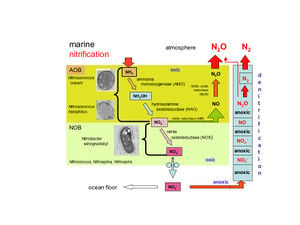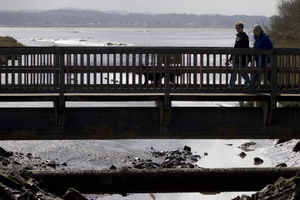Arcata marsh enhancement ponds[edit | edit source]
The enhancement ponds consists of three ponds: the George Allen, Robert Gearheart and Dan Hauser ponds. The total area covers 30 acres.[1]
History[edit | edit source]
In 1972, the Clean Water Act [2] prohibited discharge wastewater into any enclosed bay or estuary unless it could demonstrate "enhancement of the receiving waters."[3] The existing waste water plant at the time was only treating their water with primary treatment before releasing it into the bay. The most economical thing for the City of Arcata to do was expand the existing facilites to treat the waste water even further before releasing it into the bay.[4]
In 1977, the idea of enhancement ponds were developed and Dr. George Allen, Dr. Bob Gearheart, Public Works Director, Frank Klopp and City Councilman, Dan Hauser, pushed the idea through the city and county councils. [5] The city was given permission to install the ponds to enhance the discharge water. By 1986, the marshes were completed.
Enhancement Ponds[edit | edit source]
The enhancement ponds are part of the tertiary treatment system of the waste water plant. Secondary treatment process and disinfection can remove 85% of the BOD and suspended solids and nearly all the pathogens, but there are pollutants (nitrogen, phospohrous, soluable COD and heavey metals) still lingering.[1]
This water is treated in the enhancement ponds where biological processes remove the remaining pollutants before the water is released into the bay. Phosphorous can be removed by a chemical percipitation using one of three compounds: ferric chloride, aluminum or lime.[1] Nitrogen needs to be removed from the water in order to control the algae blooms. This can be done biologically or chemically. The nitrification-denitrificationprocess is used at the enhancement marshes.

The water which has been treated by the chlorine has levels of BOD and Total Suspended Solids (SS) less than 10 mg/L and Total Inorganic Nitrogen (TIN) is less than 5mg/L.[6]
Water starts in the George-Allen marsh, then travels to the Robert Gearheart Marsh and finally to the Dan Hauser marsh; this process can take up to 9 days. [7] Effluent from the Dan Hauser marsh is treated by chlorine a second time and is pumped into the bay. [8]
Plants[edit | edit source]
Plants are essential for the Enhancement Marsh to be successful. Plants help clean the water by providing habitat for fish and birds that eat algae and by providing cover to help control the growth of algae. Willows are known for their ability to absorb toxins out of the soil and cat tails and other grasses are good for habitat and shade. Plants play a role in nitrification-denitrification. The whole ecosystem of a marine environment in Figure 1 is necessary for the process to succeed.
Biodiversity is an important factor in creating a realistic environment. Using native plants in the landscape is key for restoration and rehabilitation. Friends of Arcata Marsh (FOAM) has complied a list of common plants of the Arcata Marsh. These plants include:
| Trees and Shrubs | Wetland Plants | Other Plants |
|---|---|---|
| Big-leaf Maple, Blue Blossom, California Blackberry, Canyon Gooseberry, Cascara Sagrada, Coast Redwood, Coast Willow, Coyote Brush, Himalayan Blackberry, Monterey Pine, Port Orford Cedar, Red Alder, Red Elderberry, Red Flowering Currant, Sitka Spruce, Thimbleberry, Wax Myrtle | Brass Button, Bulrush, Broadleaf Cattail, Common Mare’s-tail, Common Rush, Cordgrass, Duckweed, Jaumea, Marsh Pennywort, Marsh Rosemary, Pickleweed, Saltbrush, Sea-Arrow-grass, Umbrella sedge, Water Parsley, Water Plantain | Birdfoot trefoil, Bracken Fern, Bull Thistle, California Aster, California Poppy, Cat’s Ear, Cinquefoil, Common Horsetail, Common Plantain, Cow Parsnip, Creeping Buttercup, Curly Dock, Douglas Iris, Evening Primrose, Fennel, Fiel Mustard, Foxglove, Gumplant, Lupine, Oxeye Daisey, Pampas Grass, Pearly Everlasting, Poison Hemlock, Rattlesnake Grass, Red Clover, Roadside Everlast Pea, Queen Anne’s Lace, Sheep Sorrel, Sword Fern, Teasel, Yarrow, Yellow Parentucellia |
Activites at Arcata Marsh and Wildlife Sanctuary[edit | edit source]
Bird Watching Over 200 species of birds can be seen at AMWS. Fall and springtime are the best times to come and see the birds, especially during low tide (ACWS Map and Guide). Some of the most common birds that can be seen at the marsh include:
| Common Name |
|---|
| Black Bellied Plover , Black Turnstone , Dunlin , Sanderling , Long-billed Dowitcher , Greater Yellow Legs , Gulls: (Herring, Mew, Glaucous, Californian, Bonaparete’s) , Brown Pelican , Cormorants (Pelagic, Double-crested, Brandt’s) , Scoters (White winged, Surf, Common) , Red-Breasted Merganser , Northern Phalarope , Marbled Godwit , Long billed Curlew , Whimbrel , Canadian Goose , Common Loon , American Coot , Merlin , Grebes (Western, Red-necked, Horned, Eared) , Forster’s Tern , Belted King Fisher , American Goldfinch , Tree Swallow , Short-Eared Owl , Swipe , Red-billed Grebe , Sora , Marsh Wren , American Bittern , Wilson ’s Warbler , Savannah Sparrow , Red-winged blackbird , Song Sparrow , Virginia Rail , Least Bittern , Green-backed Heron , Black-crowned Night Heron , Osprey , Greater Scaup , Pintail , Redhead , Green-winged Teal , Mallard , Canvasback , Northern Shoveler , Bufflehead , Ruddy Duck , Great Blue Heron , American Avocets , Snowy Egret , Peregrine Falcon , Great Egret , Willet , Western Sand Piper , Black bellied Plover , Least Sandpiper , Semi-Palmate Plover , Killdeer , Redknot |

City of Arcata Volunteer Days:
- Saturday, September 20, 2008: Removal of non-native plants (9am-1pm) Sponsored by Humboldt United Way- “Day of Caring”
- Saturday, October 11, 2008: Non Native Plant Removal (9am-1pm). Sponsored by: FOAM and CNPS.
Volunteers are expected to wear work clothes and boots. The must sign a liability release form in order to participate. The City of Arcata will provide gloves, tools, first aid kits, snacks and beverages. They will also present a safety talk and too-use instructions prior to work. Contact (707)825-2163 for more information about volunteering. -Source: City of Arcata’s Forest and Marsh Volunteer Workday Schedule 2008-2009 (2/14/08)
Aleutian Goose Festival: A Celebration of Wildness (March 28-31,2008) For more information visit: www.aleutiangoosefestival.org or call 800-343-8300
13th Annual Godwit Days: Spring Migration Bird Festival (April 17th-23, 2008) Keynote Speakers: Dr. Andrew Farnsworth (of Cornell Lab of Ornithology. Spotlight Organization: Friends of the Dunes Around 100 field trips and workshops, bird fair, art show and live birds of prey. For more information visit www.godwitdays.com or call 1-800-908-WING.
Bibliography[edit | edit source]
- ↑ 1.0 1.1 Davis, Mackensie L. and Masten Susan J. "Principles of Environmental Engineering and Science." McGraw Hill Higher Education New York, NY (2004)
- ↑ "A Natural System for Wastewater Reclamation and Resouce Enhancement." Arcata, California. Friends of Arcata Marsh
- ↑ “Arcata Marsh and Wildlife Sanctuary: Map and Guide.” April 1994